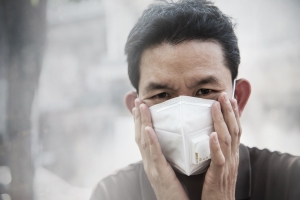The recent outbreak of Novel Coronavirus (designated 2019-nCoV) has exploded in the last several days.
What is Novel Coronavirus? The CDC and world health organizations are closely monitoring an outbreak of respiratory illness caused by a novel (not seen before) coronavirus first identified in Wuhan, Hubei Province, China in early December, 2019. The growing epidemic centers around a densely populated area (close to 20 million people in a cluster of 3 cities) in central China which is also a major manufacturing and transportation hub. The timing of the outbreak also coincided with the Chinese New Year, which is the peak travel season in China.
2019 Novel Coronavirus spreads through the air when an infected person coughs or sneezes. Symptoms are thought to appear within two to 14 days after exposure and consist of fever, cough, runny nose, and difficulty breathing. The infection may cause only mild illness in some individuals, but can lead to severe pneumonia and death, especially in those who are older or have other chronic diseases.
This new member of the coronavirus family is very closely related to viruses responsible for previous global outbreaks of SARS (Severe Acute Respiratory Syndrome) in 2003 and MERS (Middle East Respiratory Syndrome), first identified in Saudi Arabia in 2012. Growing evidence suggests that the virus may have originated in bats and mutated to make the jump to humans.
Current Status and Forecast
As of January 28, 2020, China’s National Health Commission reported close to 6000 cases and 132 deaths, an increase of 25% from only the previous day. Experts warned that the actual number of cases could be significantly higher and growing quickly.
Per the CDC, the outbreak has quickly spread outside of China with cases of infection now confirmed in Thailand, Hong Kong, Taiwan, Australia, Macau, Singapore, South Korea, Malaysia, Japan, France, Canada, Vietnam, Nepal, Cambodia, Germany and the United Arab Emirates. Almost all of those cases involved recent travelers from China. Five cases have been confirmed in the US, including one in Arizona in the ASU (Arizona State University) community. That individual is reported to have traveled recently from Wuhan and is presently under quarantine and being followed closely by state and federal health officials.
Recent cases have been reported in Germany from people who had not traveled but had contact with an infectious individual, indicating that person to person transmission is possible.
The Chinese government has imposed travel restrictions in an effort to contain the outbreak and many countries are considering restricting travel to the region. International travelers can expect routine screening at airports around the world, including 20 airports in the US. Anyone with respiratory symptoms or a fever could be subject to quarantine. Several nations, including the US, are evacuating their citizens out of China.
Epidemiologic models developed by researchers at the University of Hong Kong collaborating with the WHO (World Health Organization) indicate that 2019-nCoV may be about to become a global epidemic. The number of cases is not expected to peak until at least late April or early May 2020 and recent quarantines in China are predicted to have limited effect.
What precautions can travelers take?
1) The CDC has issued a Level 3 Travel Health Notice recommending that travelers avoid all nonessential travel to the entire country of China.
2) Make sure you have had your flu shot for this season (recommended for everyone over the age of 6 months), since the symptoms of influenza are indistinguishable from those of 2019-nCoV infection. Also ensure you are up to date with your pneumonia vaccines if you are over 65 or have other chronic illnesses.
3) Avoid close contact with people who are obviously sick.
4) Wash your hands often with soap and water (for at least 20 seconds). If soap and water are unavailable, use an alcohol based sanitizer.
5) Avoid touching unwashed hands to your face, eyes, nose and mouth (even if you are wearing a mask). This is one way that previous coronaviruses have been found to spread.
6) Stay home when you are sick. If you have a cough, practice “cough etiquette”. Cough or sneeze into your sleeve or cover your mouth with a tissue and dispose of it immediately.
7) Avoid touching potentially contaminated surfaces in public areas and consider wiping down frequently used surfaces like counters or airplane tray tables with a disinfecting wipe.
8) If you are in airplanes or airports, consider wearing an N95 respiratory mask - a special close fitting mask certified to block 95% of potentially infectious particles - even though there is not a lot of solid, reliable data to support their effectiveness. Consider purchasing one soon if you have planned upcoming travel. Large centers around the world are already reporting shortages of the masks. Regular surgical or cloth masks likely offer less protection but may still block larger airborne droplet particles.
So far, deaths from 2019-nCoV infection are somewhat limited and the outbreak does not generally pose an immediate or serious threat to US residents. However, the situation is evolving rapidly and international travelers should be prepared and plan accordingly. Schedule a pre-travel consult with a travel health specialist, especially if you have upcoming travel to Asia and stay tuned to the TravelBug Health website for updates.

